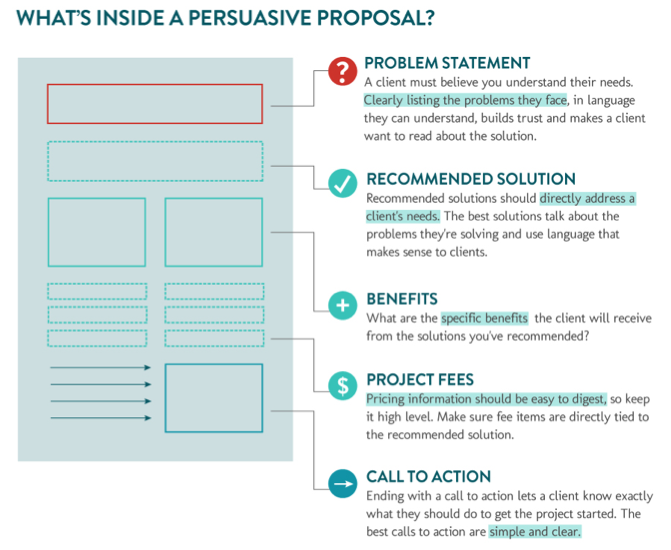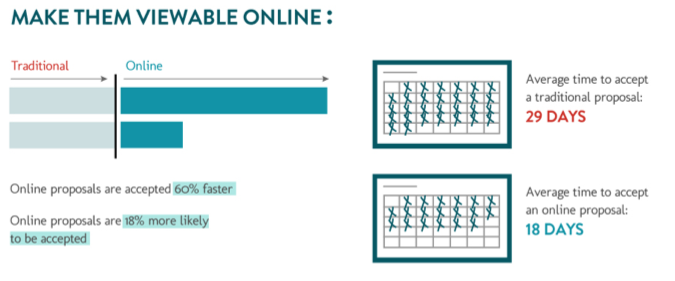What You Need to Know About Web Design Proposals
Most web designers use the wrong proposal template.In fact, most of their "proposals" aren't even proposals at all. They're "estimates.”
Unfortunately, an estimate is an ineffective sales presentation that focuses on price. When you create an estimate, you're shifting the prospect's attention on what exactly will be done and how much it costs.
But that's not where you want the prospect to focus. Instead, you want the prospect to focus on the value you will create. Not the price.
That's what a proposal is. It's a persuasive sales document that shows your prospect that you know what they need and that you're the right person for the job.
So how much more persuasive is a proposal than an estimate? Our research found that 43% of the average proposals win, while only 35% of estimates win.
To create a true proposal, you must include these five elements:
- Demonstrate you understand their problems with a Problem Statement
- Explain your Recommended Solution
- Explain the Benefits of your solution
- Explain the Project Fees
- End with a Call to Action to buy
 Since your proposal should always include those five elements, it’s
helpful to use a web design proposal template that outlines for what
goes in each section. So let’s look at what each section is all about.
Since your proposal should always include those five elements, it’s
helpful to use a web design proposal template that outlines for what
goes in each section. So let’s look at what each section is all about.1. Problem Statement
Before you can write a good Problem Statement, you need to understand the prospect’s most painful problem. Often, it's not what you think.For instance, say a local car wash wants a new website. It'd be easy for a web designer to assume that the problem is that their site looks old and dated.
That designer might write a Problem Statement like this:
Squeaky Clean Car Wash needs a new look for their website, including a complete redesign of the site and a new logo.
However, when you assume you know what the prospect's problems are,
you're often wrong. Happily, there's a surefire way to identify a
prospect's problem: simply ask them what their problems are.Then, once you know you know their problem, you can write a Problem Statement that demonstrates understanding and wins their trust.
Using this approach, web designer #2 would ask the prospect about the problems the business is currently facing. As it turns out, the biggest problem is that customers are having a hard time finding the car wash on a side street. Several customers have complained.
Armed with this information, web designer #2 writes the following Problem Statement:
Squeaky Clean Car Wash needs a
website that helps customers navigate to the car wash, whether they’re
viewing the site from a desktop computer or a mobile device.
If you owned Squeaky Clean Car Wash, which designer would you hire? When you write a Problem Statement that demonstrates that you understand a prospect’s problem, you’ll win them over...even if you’re charging more than the other guys.
2. Recommended Solution
After you’ve stated the problem, you need to prove that you’re the one to solve it.But if you explain your solution in your own words, the client’s eyes will glaze over. For instance, take a look at this Recommended Solution:
Acme, LLC, will create a new
company intranet to increase cross-department synergy and enable
knowledge management throughout your company. This intranet will achieve
that through: (1) an employee directory, (2) a blog for internal
corporate announcements (3) a comprehensive employee survey facility for
360-degree feedback.
There are two big problems with a Recommended Solution section like
that. First, the client doesn't understand your jargon. And second, the
client doesn’t care about the technology you use, they only care about
the results.So what should you do instead? Use your client’s words.
To do this, take notes when you talk to your prospect. A good Q&A session might go something like this:
Q: Why are you looking to create a new company portal?
A: We’d like to improve internal communication.
Q: Ah, OK. Can you tell me about some specific problems you’re seeing due to this lack of communication?
A: Sure. Every year in our employee survey, communication is one of the biggest complaints. Employees say that we don’t listen to their concerns and suggestions on how to improve the company. Also...
A: We’d like to improve internal communication.
Q: Ah, OK. Can you tell me about some specific problems you’re seeing due to this lack of communication?
A: Sure. Every year in our employee survey, communication is one of the biggest complaints. Employees say that we don’t listen to their concerns and suggestions on how to improve the company. Also...
We can easily swipe this client's words for our proposal:
Every year, the employee
survey shows that employees feel like management doesn’t listen to their
concerns and suggestions on how to improve the company. The new company
portal is going to change that perception. This portal will...
The fact is, most people love to hear themselves quoted back to them.And by using their language, you create empathy and trust with your prospect.
3. Benefits
Your Benefits section needs to sell, sell, sell. But sadly, many web designers write generic content here or copy and paste some template filler.For instance, let’s say a recipe website asks you for some SEO work to improve their Google juice. Most proposal writers would take this as a chance to copy and paste a whole section about "How SEO Can Improve Revenue."
You might think it saves you time, but stale content is the kiss of death. Our research shows the best proposals contain 50-80% fresh content.
Plus, think about it... If your prospect didn't already know that SEO can improve revenue, would you have been asked to write a proposal?
Instead, write fresh content that explains specifically how you will help your client.
For instance, here's one way you could write the Benefits section for that recipe site:
According to your Google
Analytics report, Meatball Recipes already gets 100 visits a month from
visitors searching for "spicy meatball recipe." Your site ranks #12 for
that keyword, which means you're on the second page on Google. We
estimate that the #10 result gets 1,000 visits a month. So even a slight
improvement to rank #10 for "spicy meatball recipe" would 10x your
traffic for that keyword.
The best part is that this dynamic template content is just as
recyclable as stale template filler. If your next proposal is for, say, a
local bike shop, you could use this same basic text and just change the
keywords and numbers.4. Project Fees
We’ve already touched on the difference between estimates and proposals.To recap, estimates focus on price, or what will be done and how much it costs. Proposals, on the other hand, focus on the value you will create.
Of course, proposals do include a Project Fees section, but there’s a right way and a wrong way to write it.
Let’s take a look at an example of the wrong way to write a Project Fees section:
| Installation of Wordpress | $ 500 |
| Purchase of custom theme | $ 50 |
| Customization of custom theme | $ 250 |
| Creation of 17 Wordpress Pages | $ 500 |
| SEO optimization audit | $ 300 |
| Total cost | $1,600 |
Instead, go back to the client’s Problem and answer this question: how much does it cost to solve the Problem?
To do that, tie your fees directly to the Recommended Solution, and keep them high-level so they’re easy to understand. Here’s how to do that, using our previous example:
| Create website with custom theme | $ 800 |
| Write website content | $ 500 |
| SEO services | $ 300 |
| Total cost | $1,600 |
5. Call to Action
Okay, so you've written a persuasive sales document that outlines the problem, the solution, the benefits, and the price. Are you done?Not yet!
The client still has to take action and hire you.
But don’t just cross your fingers and hope they’ll call. Instead, include a clear "call to action" to let the client know exactly what they should do to get the project started.
But there's a secret about selling that we haven't mentioned yet. And it's something you already know, but are probably underestimating.
Here's the secret: your client is extremely lazy.
OK, so you already knew that. But do you fully appreciate how lazy they are?
Believe it or not, we tend to give too much credit to our prospects. In the perfect world of our imagination, clients read your awesome proposal, are convinced that you can solve their problem, and immediately pick up the phone to excitedly agree to your proposal.
In the actual world we live in, clients read your awesome proposal and are convinced. But oops! They forget to call you right away. They certainly won't print out your proposal, sign it, fax it back, and mail you a check.
And when you call or email a few days later, they've forgotten how awesome your proposal was. They're just not as excited like they were...
So how do you strike when the iron is hot?
Use a 1-Click call to action in your proposals. All you have to do is abandon the world of paper and PDF proposals and switch to using online proposals.
Then you can make your call to action a giant button that prospects can click to accept your proposal.
This sounds like such a small thing to do. You're probably thinking that it won't have much impact...
Actually, it has a HUGE impact.
Our research shows that online proposals are accepted 60% faster than traditional proposals, and they’re 18% more likely to be accepted overall.
 Why does this work so well?
Why does this work so well?There are two reasons.
First, with online approvals, your clients don’t need to print, sign, scan, and email or fax your proposal back to you. Everything is online, in one place, and simple to execute.
Second, and more important, by making the next step a click away, you turn your prospect's laziness into your secret weapon. You're actually making it easier to accept your proposal than it is to keep on worrying about the problem or even read the next proposals.
You're striking while the iron's hot.
And the Finishing Touches
In addition to the main five elements, a proposal for a large project should include an estimated schedule. That gives the client a timeframe for each step of the project.Once you’ve written a basic outline for each section, create a simple header and footer to “brand” your proposal.
This sounds easy, but it can be a little tricky. You want your proposal to look professional and hint at your creative abilities, yet you don’t want prospects to be distracted from the content.
If creating your own proposal templates from scratch sounds like too much work, there’s an easier way: proposal software.
With software like Bidsketch, all you have to do is select the template and provide the content. Your proposals get to the client faster, and all they need to do is click a button to say “yes".
Whether you opt to DIY or to use software, a persuasive proposal will show the prospect exactly how you will create value. And that's all the prospect cares about!
No comments:
Post a Comment